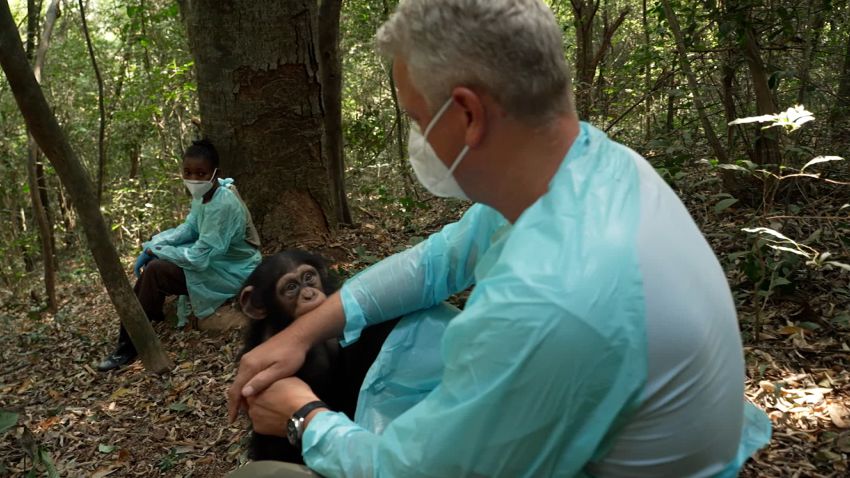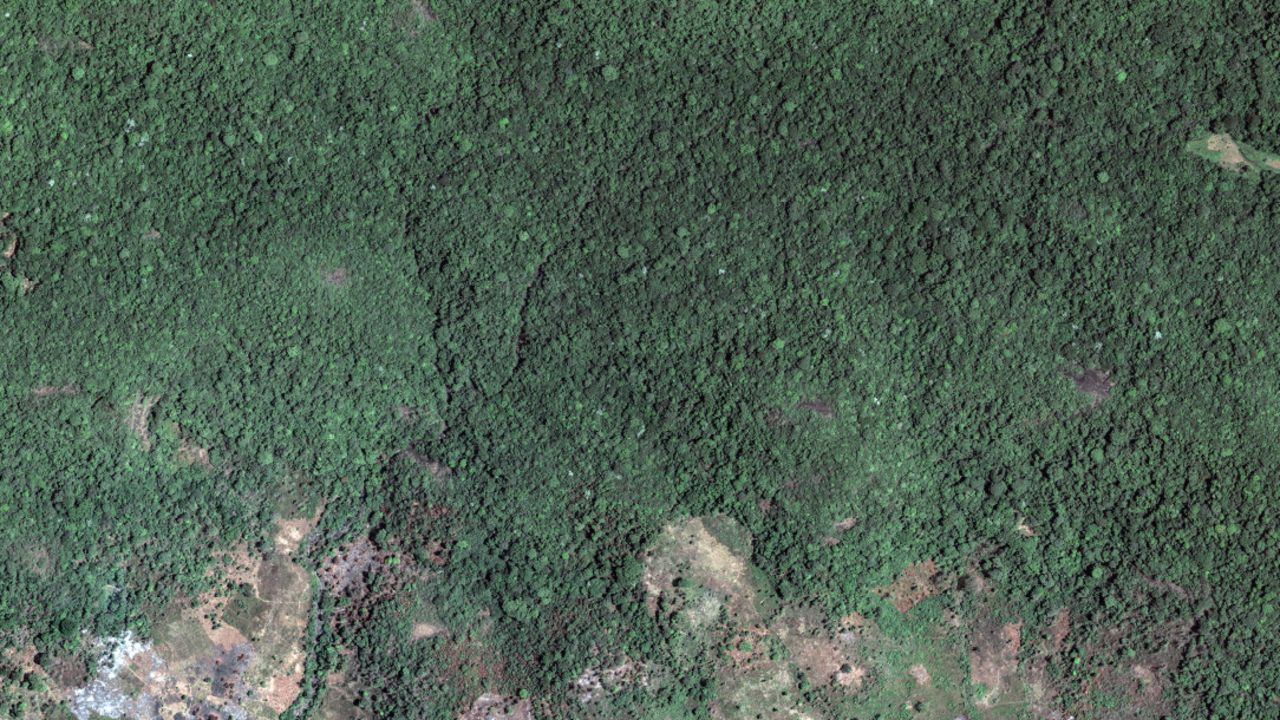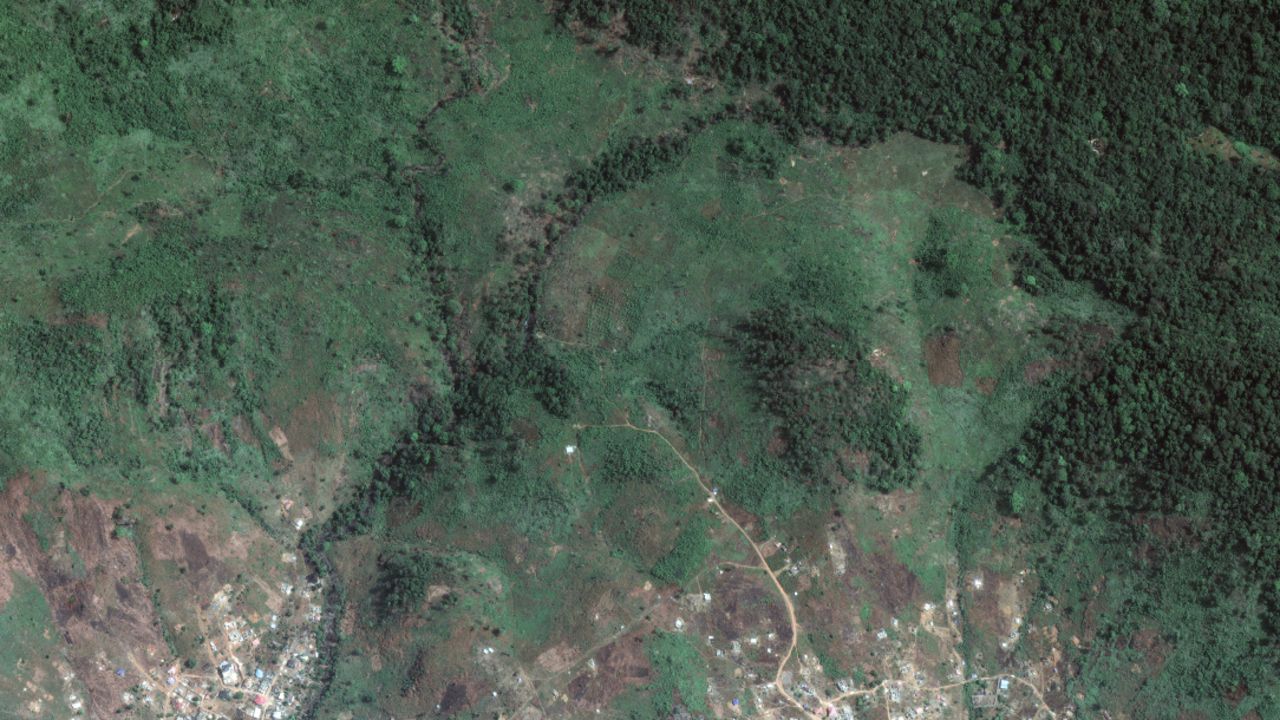When it comes to chimpanzee toddlers, girls rule. Skippy climbs with her hands and feet into the forest canopy, swinging through the spindly vines. The boys: they prefer to cuddle with their human carer.
They are all orphans, rescued from across Sierra Leone and raised at the Tacugama Chimpanzee Sanctuary.
“I want them to get used to the forest. So, when they join a new group, they will be ready,” says Mamma Posseh, who everyone calls Mamma P. She is the surrogate mother to the baby chimps.
The three chimps at forest school are some of the newer arrivals to the sanctuary, an oasis for more than 100 of our closest relatives inside Sierra Leone’s Western Area Peninsula National Park.
The sanctuary not only shelters orphaned chimpanzees but serves as a conservation leader in Sierra Leone, managing several national parks, and battling against rapid deforestation that threatens the entire region.
“Chimps are so much like us, we need to care for them” says Bala Amarasekaran, the founder of Tacugama.
He has become something of a legend in Sierra Leone. An immigrant from Sri Lanka who arrived with his family as a teenager, Amarasekaran and his wife rescued their first chimp in 1988 on a trip north, around 150 miles from Freetown. He was tied to a tree in a village, like many orphaned chimps, being kept as a pet. They called him Bruno.
“Once I met that first chimp, he started showing us the way. It’s not about just that chimp, it is about the species,” Amarasekaran says.
That one chimp soon became seven - and the sanctuary was born in 1995.
Amarasekaran has managed Tacugama through Sierra Leone’s brutal civil wars and heart-stopping Ebola outbreaks. Along the way he’s pushed chimps into the national consciousness, lobbying for the primate to become the national animal in 2019. Bruno’s picture is now on the national passport.
But sometimes publicity isn’t enough and the park faces an ominous threat. The once almost 18,000-hectare Western Area Peninsula National Park is on a wedge of forest hemmed in by the country’s capital, Freetown.
The wedge is shrinking fast.
Regular satellite analysis funded by the World Food Program shows that the park has lost a quarter of its forest since just 2016. The canopy decimation is replicated throughout Sierra Leone and much of West Africa. Recent analysis of long-term losses show that more than 80% of the region’s forests have vanished.

Once lost, impossible to get back
It’s an ecological crisis that was triggered by colonial-era exploitation and continued destruction post-independence.
“If you came here two years ago, there was not a single building or any of these makeshift shelters. Nothing was there,” says Amarasekaran, as he points to a scar of development butting the forest. “I have been fighting this thing for 30 years, not 30 days.”
This kind of precarious development on the steep hills around Freetown can be deadly. In 2017, part of the mountain collapsed, leaving more than 1,000 people dead or missing in a landslide.
Despite the risks, the wealthy and well-connected continue to carve their spots in the hills, giving rise to unchecked development that endangers vital water supplies for the city.
“They want to be above the hoi polloi. The reality is that they get a foothold through bribery or weak officials and then it’s a field day,” says Sonkita Conteh, the Sierra Leone director of Namati, a land rights group that focuses on legal reform. Once one large, brick home pops up, shacks and settlements follow, he says.
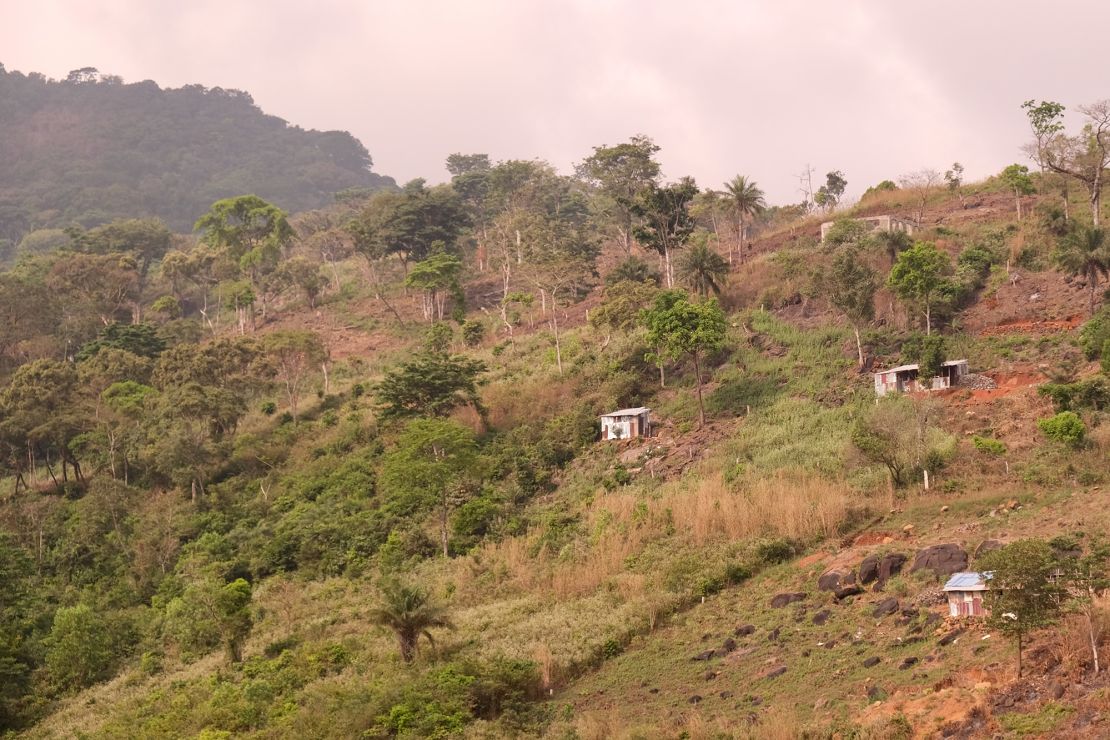
Parks like the Western Area have buffer zones, to delineate the protected zone from settlements. But Conteh says those keep changing - often because of corrupt or opaque deals. He says customary land rights in rural areas, which have given local chiefs the power to make land deals, have also led to rampant land grabs.
For Sierra Leone’s capital, the stakes are high. In the center of the mountains of the Western Area Forest, a verdant valley drops into the Guma Dam reservoir. It is the main source of water for an estimated two million inhabitants of the sprawling city. And the forest anchors that supply.
A new land rights act passed in 2022, with considerable help from Conteh and Namati, aims to tighten regulations, offering protection against predatory development.
But land is still being lost and Conteh points to the fires burning close to the catchment area as a new land grab gets underway.
It’s the dry season and water restrictions are in effect. Deep in the forest, companies are mining for granite – the roads they build open a doorway deeper into virgin land. Nobody seems to know how they got their permissions, says Conteh.
“The animals are important, certainly, but the humans need water. Once you have lost it, it’s impossible to get it back. We need to protect what we already have. It’s not much, but I think we can start from there,” he says.
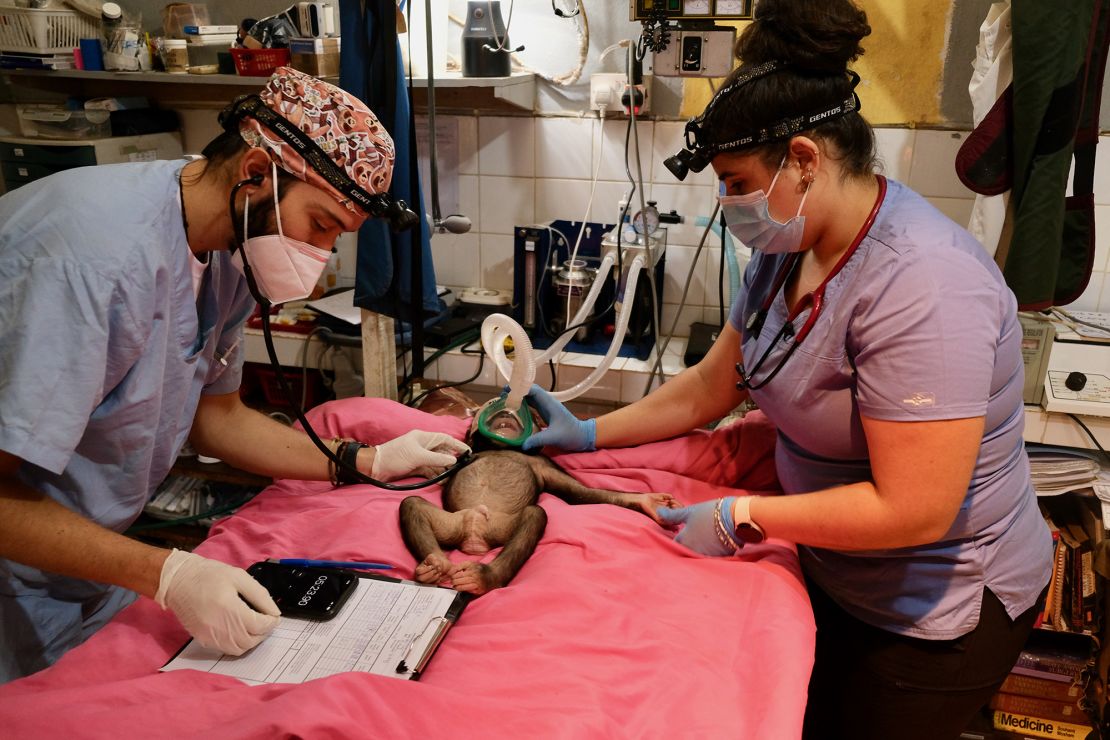
As the forest shrinks, the number of orphaned chimps at Tacugama expands. Siama came in just a few weeks ago. He is still in quarantine, to make sure that he doesn’t transfer any diseases to the population at the sanctuary.
Veternarian Zoe MacIntyre believes that Siama’s mother was shot by a hunter. The shotgun pellet lodged in his shoulder is visible as she performs an x-ray.
“He was really weak when he arrived,” says Macintyre. “He couldn’t even control his head movements.”
Together with another Tacugama vet, she does a series of tests on Siama to see when he can be introduced to his surrogate family.
Mamma P waits anxiously to take Siama when they finish. She gives the new arrivals to the sanctuary special care.
“He likes to play with me and likes to stay with me. If I try to leave, he starts screaming,” she says, as she feeds Siama a slice of watermelon.
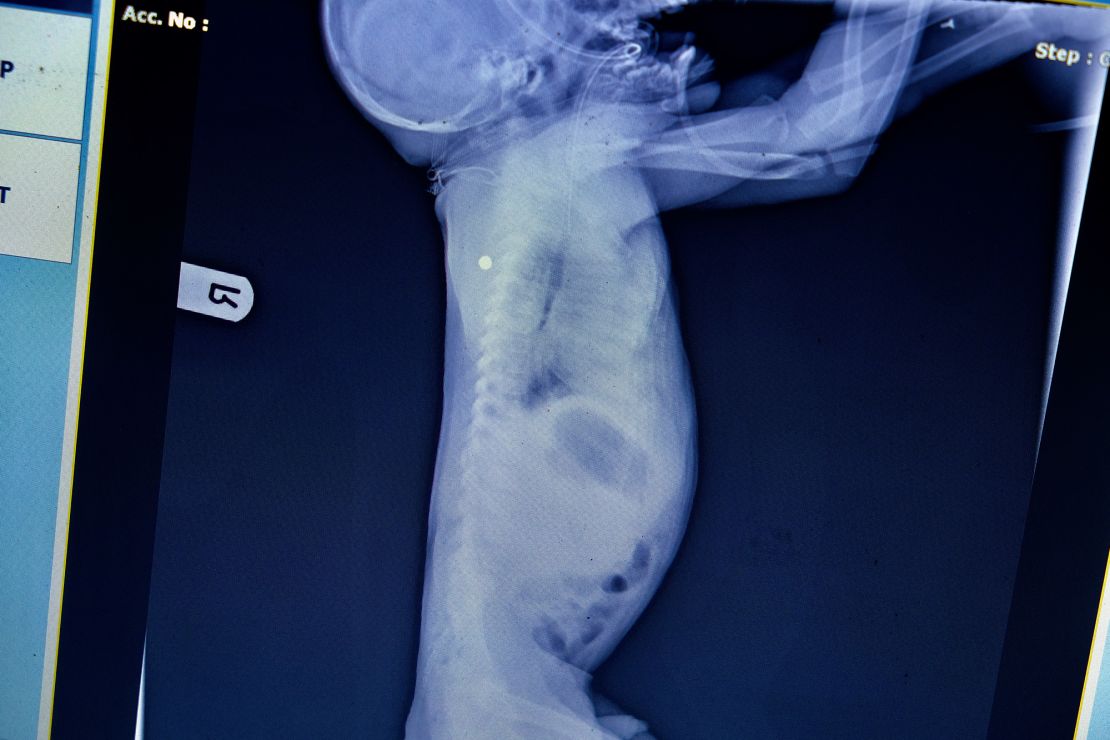
‘About preserving humans’
Looming over all of this is the biggest threat of all.
The rampant destruction of West Africa’s forests, and forests across the continent, has a significant impact on the climate crisis.
One study estimates that between 2010 and 2018, the region lost more than 22,000 square miles of forest.
Clearing forests is a one-two punch: when they are destroyed, the carbon stored in the vegetation is released into the atmosphere and contributes to global warming — at least 12% of the world’s carbon pollution comes from forest loss. It also means losing one of nature’s most powerful tools in sucking carbon dioxide from the atmosphere.
While the Amazon rainforest gets much of the world’s attention, Africa’s swaths of primary forests are vital. Primary forests, which are old and have had minimal human intervention, are far better than newer ones at pulling in carbon.
Sierra Leone has lost an estimated 35% of its forest cover since 2000. With only 5,500 wild Western chimpanzees remaining, the chimpanzee population’s fate reflects the health of the forest.
Chimpanzees thrive in primary forests. If their wild populations are healthy, it means the forest is healthy.
But Amarasekaran sees an opportunity. His life’s work is convincing people to save the wild chimp. He believes if we can protect the chimp’s home, we can protect ours too.
“This is not a forest problem or an animal problem. It is going to affect humans,” he says. “This is no longer about preserving the forest or the wildlife, it’s about preserving humans.”


